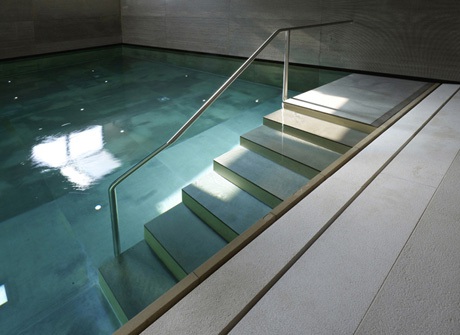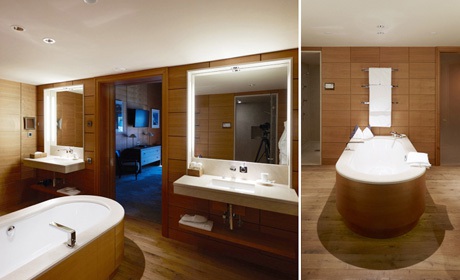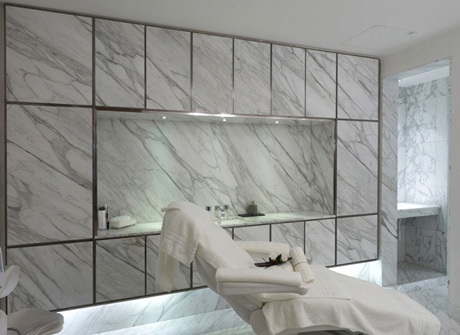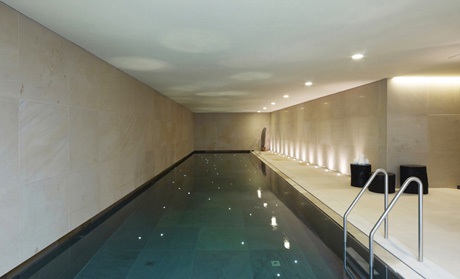Sensorial spaces by Sibylle Schaschl

Detail of the swimming pool entrance with coverings in smooth Sahel stone and natural Namibia.
One of the key aspects in the 3rd-millennium global culture is the constant and specific attention on mental and body wellness; theories, practices and products aimed to mind and body care are peculiar of a new organicism, able to radically define sensorial and emotional experiences. In this scenario spaces devoted to well being have substantially changed their structure and aspect: in particular the bathroom has become, both in private houses and public places, an environment devoted to wellness and body care practices overcoming the simple hygienic values and moving toward complex aesthetical and therapeutic functions, including personal entertainment. The bathroom expands its boundaries, the concept of its service purpose comes down, the environment merges with the bedroom, its walls get more rarefied and projecting it is as accurate as for sitting or living rooms; in the past it was a reserved and inscrutable space, now it becomes a place of exposed visibility, at the same time background and protagonist of new multi-sensorial rituals.


A swimming pool in the wellness centre with coverings in smooth or striped Grigio Tunisi stone and floorings in Pietra Senape.
It’s easy to understand that, in this context, stone materials get a privileged employment, spreading their qualities at full spectrum, stimulating vision, hearing, touch and smell; this happens in private bathrooms as well as in spas, wellness centres – both independent or integrated in complex systems as thermal environments or hotels. In the renovated interior design of the body care spaces a synesthetic interaction opens new boundaries between human beings and stones: stone coverings, floorings, pool borders can be experienced with one’s naked body, they can be rough or polished, hot or chill, dry or humid; boulders or excavated stones can resonate differently according to the various forms of water (gentle flows, drops, pouring waterfalls); steamy stone materials, outdoor or indoor, surrounded by vapour, can contribute to olfactive stimulations.

A jacuzzi in the wellness centre with coverings and floorings in Grigio Tunisi and Pietra Senape.
For a long time Austrian designer Sibylle Schascl has specialized in projecting interiors for high-quality houses and hotels in mountain locations, expressing a refined interpretation of this sensorial conception of stones. Shaschl’s settings re-interpret with a contemporary taste the Alpin building tradition and are characterized by simple shapes, light volcanic or greyish colours, vast natural coverings rich in tactile qualities. Among his most recent works, we can find Aurelio hotel in Lech, a ski resort in the Rhaetian Alps, in the Western part of Austria; in this building the architect uses limestones, sandstones, marbles and quartzites with striped, smoothed or polished finishes, choosing from Pibamarmi’s and melStones’ collections of stones.


In the suite bathrooms there are settings in alternatively grey Vicenza stone and wood with natural finishes.
This hotel is an exemplary model of contemporary luxury hotelery, based on a renovated idea of hospitality developed in recent years and characterized by a continuous expansion of the spaces, both of the private ones as rooms or suites and of the shared ones (receptions, halls, dining rooms); environments for body care, meditation and meetings can also be added to the list. Sibylle Schaschl’s works concretely realize the concept of global and complex hospitality place, equipped with a vast series of comforts and integrated services and structured as a temporary residence rich in significance and interpersonal values, able to become a must-see destination not only for winter sports tourism but also for a refined cultu

An equipped wall in the wellness centre covered in polished Statuario Venato marble.
In this renewed typology hotels become “independent cities”, in which different spaces and aesthetics mix together and several overlapping functions are developed in the same structure. Here stones get the strategic and flexible role of a unique presence, or dominant if in association with other natural materials as wood.

View of a pool in the wellness centre with coverings and floorings in smoothed Gray and Sahel stones.
As mentioned above, the places where stone is used the most are the big bathrooms of the suites and the shared spaces for wellness and beauty treatments; here stone starts a direct sensorial relationship with the corporeity of Aurelio Hotel’s guests, underlining the renovated interest of the contemporary age for the natural and authentic qualities of the primeval stone essence.
di Davide Turrini